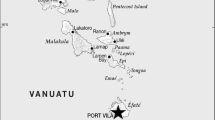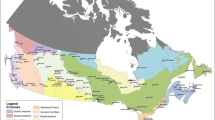Abstract
A complex set of social, economic, cultural and environmental circumstances affecting native Canadians in northern regions has resulted in the dietary replacement of indigenous foods with marketed products not always of equivalent nutritional value. This article examines the current food supply in three northern Manitoba Cree communities by looking at the availability and preservation of traditional foods, the price of marketed foods and perceptions of the food supply. Data were obtained by questionnaire from older adults (over 55 years) and younger women (16–45 years) in each community. The food supply comprised a mix of traditional and marketed foods, with limited use of traditional methods of food preservation. Marketed food prices were high in communities without all-weather road access. Respondents expressed a desire for more traditional food. Promotion of traditional foods could increase nutrient intake, decrease food costs and contribute to a revival of interest in Cree culture.
Résumé
Un ensemble complexe de conditions sociales, économiques, culturelles et environnementales influençant les autochtones des régions du Nord du Canada a abouti au remplacement des aliments autochtones traditionnels par des produits commerciaux qui n’ont pas toujours la même valeur nutritive. Cet article étudie l’approvisionnement alimentaire actuel dans trois communautés Cree du Manitoba en examinant la disponibilité et la préservation des aliments traditionnels, le prix des aliments commerciaux et comment ces aliments sont perçus par la population. Les données ont été recueillies à l’aide d’un questionnaire envoyé aux adultes plus âgés (plus de 55 ans) et aux femmes plus jeunes (16 à 45 ans) dans chaque communauté. Les aliments disponibles comprenaient un ensemble d’aliments traditionnels et commerciaux, avec un recours limité aux méthodes traditionnelles de préservation des aliments. Les prix des aliments commerciaux étaient élevés dans les communautés ne disposant pas d’une route d’accès ouverte en tout temps. Les répondants ont dit qu’ils souhaiteraient disposer d’une plus grande quantité d’aliments traditionnels. La promotion des aliments traditionnels pourrait permettre d’augmenter l’apport nutritif, de diminuer le coût de l’alimentation et de contribuer à un regain d’intérêt pour la culture Cree.
Similar content being viewed by others
References
Kuhnlein HV. Nutritional value of traditional food practices In: McLoughlin JV, McKenna BM (Eds.), Research in Food Science and Nutrition, Vol 4, Food Science and Human Welfare. Dublin: Boole Press, 1984;63–71.
Campbell ML, Diamant RMF, Macpherson BD. Dietary survey of preschool children, women of child-bearing age, and older adults in God’s River, Nelson House and South Indian Lake, Final report to Medical Services Branch, Health and Welfare Canada (Contract No. H3551-9-N125/01-XSF), 1992.
Campbell ML, Diamant R, Macpherson BD, et al. Energy and nutrient intakes of men (56–74 years) and women (16–74 years) in three northern Manitoba Cree communities. J Can Dietet Assoc 1994;55:169.
Summary Report. Canada-Manitoba agreement on the study and monitoring of mercury in the Churchill River Diversion, 1987.
Medical Services Branch, Health and Welfare Canada. Methylmercury in Canada. Volume II. Ottawa: Minister of National Health and Welfare, 1984.
Waldram JD. As Long as the Rivers Run. Winnipeg, Man: The University of Manitoba Press, 1988;164.
Campbell ML, Diamant RMF, Grunau M, Halladay J. Conducting dietary surveys in aboriginal communities: methodological considerations. Can Home Econ J 1994;44:118.
Kuhnlein HV. Nutritional and toxicological components of Inuit diets in Broughton Island, Northwest Territories. Yellowknife: Dept. of Health, Contract Report, 1989.
Wein EE, Sabry JH. Use of country foods by native Canadians in the Taiga. Arctic Med Res 1988;47:134–38.
Lawn J. Nutrient intake of adults aged 15–65, Big Trout Lake, Weagamow Lake, PCB Health Study. Ontario: Medical Services Branch, 1989.
Robbins LG, Robichon-Hunt L. The Agriculture Canada Nutritious Food Basket and the Thrifty Nutritious Food Basket. Food Market Commentary 1989;11:31–42.
Young TK. Health Care and Cultural Change. The Indian Experience in the Central Subarctic. Toronto, Ont: University of Toronto Press, 1988;5.
Berkes F, George P, Preston R, et al. Wildlife harvests in the Mushkegowuk region. TASO Report, Second Series, No. 6. Hamilton, Ont: McMaster University, 1992;67.
Ritenbaugh C, Szathmary EJE, Goodby C, Feldman C. Dietary acculturation among the Dogrib Indians of the Canadian Northwest Territories. Ecology of Food and Nutrition 1996;35:81–94.
Wein EE, Sabry JH, Evers FT. Food health beliefs and preferences of northern native Canadians. Ecology of Food and Nutrition 1989;23:177–88.
Health Canada. Native foods and nutrition. Ottawa: Supply and Services Canada, 1994;14.
Manitoba Bureau of Statistics. Prices Monitoring Survey. Manitoba Statistical Review, Second Quarter, 1991.
Indian and Northern Affairs Canada. Food for the north: Report of the air stage subsidy review. Ottawa: Supply and Services Canada, 1990.
Wein EE. The high cost of a nutritionally adequate diet in four Yukon communities. Can J Public Health 1994;85:310–312.
Campbell ML. Food prices in the North — a threat to food security. Issues in the North, Vol 2. Edmonton: Canadian Circumpolar Institute (in press).
Author information
Authors and Affiliations
Additional information
Funds for this research were provided by the Medical Services Branch, Health Canada (Contract No. H3551-9-N125/01-XSF).
Rights and permissions
About this article
Cite this article
Campbell, M.L., Diamant, R.M.F., Macpherson, B.D. et al. The Contemporary Food Supply of Three Northern Manitoba Cree Communities. Can J Public Health 88, 105–108 (1997). https://doi.org/10.1007/BF03403871
Received:
Accepted:
Published:
Issue Date:
DOI: https://doi.org/10.1007/BF03403871




